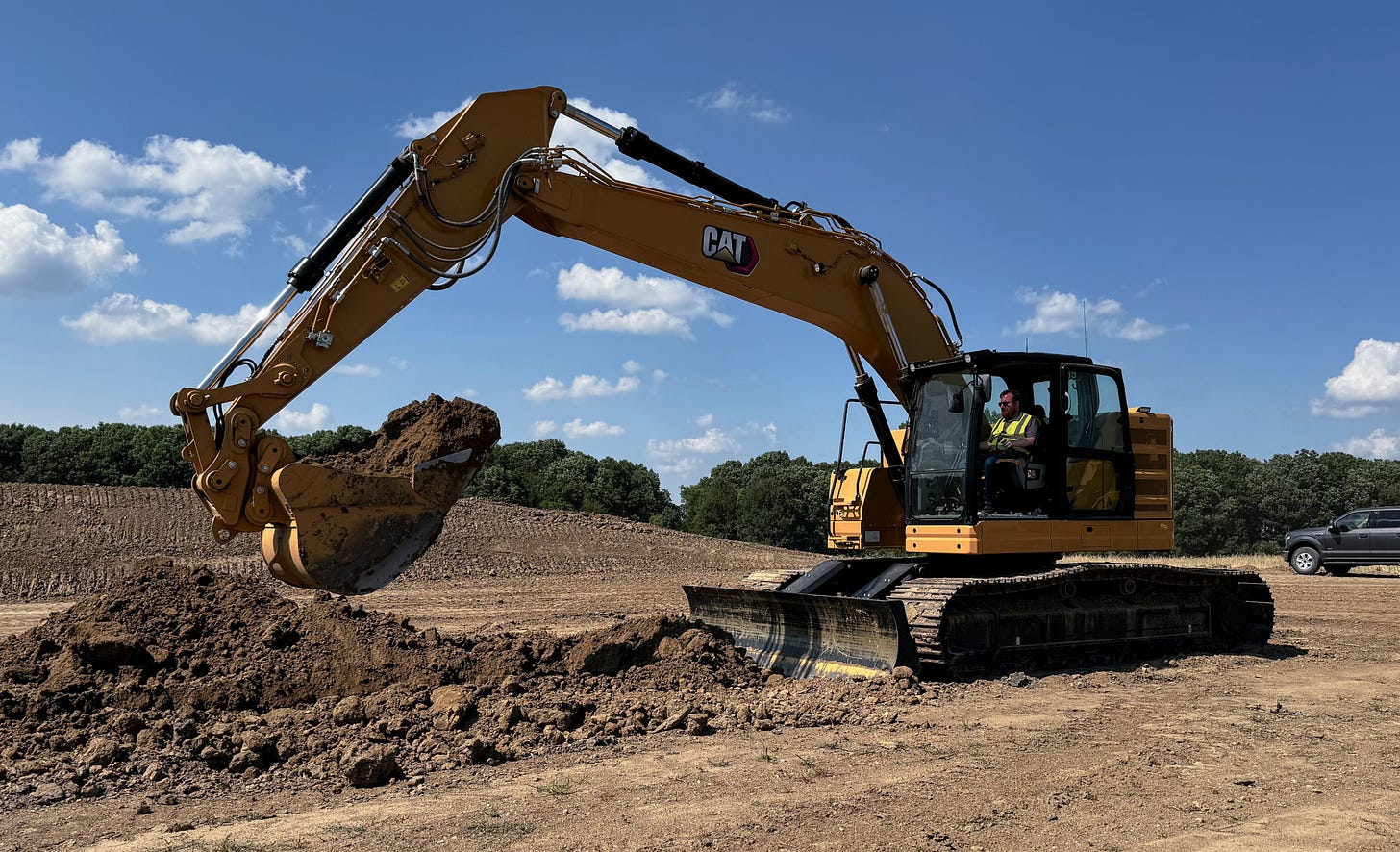PEORIA, Ill. — If I were 10 years old, Caterpillar’s Edwards Demonstration and Learning Center would be the greatest place on earth.
While the learning-focused classrooms, complete with giant screens for PowerPoint sessions on safety (that’s big here), aren’t particularly exciting, the massive demonstration area is best described as an enormous sandbox for some of the biggest toys on earth: dozens of examples of Caterpillar construction equipment.
I’d come to the midwest of the midwest to tag along with a bunch of Caterpillar’s best dealers and customers as the company demonstrated how its fanciest new tech helps build better bridges, roads, golf courses and anything else you might care to sculpt out of, or into, the earth.
If you’ve never operated an excavator, the one I played with had two joysticks, buttons, pedals and all manner of things. Move one stick one way and the bucket pivots to fill or dump. Move it the other way and the boom pivots at another joint to help you get the bucket exactly where you want.
And then, as if things weren’t complicated enough, the other joystick controls a third joint. In the hands of Caterpillar’s highly skilled demonstration team, it looks like ballet. In my hands, it looked like what I probably look like trying ballet.
Sure, I dug a hole and moved some dirt around, but what if there was a gas main five feet down, and I needed to dig a three-foot trench? Luckily, Caterpillar has some whiz-bang cleverness to help me out.
With a few taps of a screen, you can set virtual fences that the teeth of your bucket will refuse to cross. I adjusted my limits and was suddenly digging a perfect hole, precisely 3 feet deep. No matter what I did, the teeth wouldn’t go any deeper than that, keeping the imaginary gas line safely intact.
Other electronic nannies prevent you from sending the bucket into the excavator’s cab, which is a terrifying thought I’d never considered. And you can set a virtual fence that prevents you from swinging the whole thing into an adjacent lane in a highway construction zone or up into overhead power lines.
And that’s just the start — the construction equipment equivalent of automatic emergency braking in an automobile.
While those features are focused on safety, a site engineer can (if you subscribe to the appropriate services that Caterpillar offers for a price they declined to share with me) upload schematics and plans straight to a tablet in the cab. This allows an operator to see exactly what they’re supposed to be working on and will dynamically set a virtual fence so the bucket only digs where it’s supposed to.
Even a novice like me could easily dig a 50-foot-long, 3-foot-deep trench if the schematics were correct. Anyone who has ever been involved in construction, whether at a house you were building or even just some landscaping project, knows that the risk of digging in the wrong place is real.
With Caterpillar’s cloud-connected 3D planning tech, the measure-twice is suddenly complete, and the operator is sent on to handle the cut once.
Difficulties in attracting labor were a common theme throughout the event, and I asked an instructor if all this tech made it challenging to get operators into cabs. But I had it backward: The safety and 3D planning features made it so relatively unskilled operators could do complicated jobs that would have taken decades of experience to pull off if they needed to be done manually.
While I still couldn’t do ballet, Caterpillar offered a pair of shoes that could handle the fancy footwork on my behalf.
And then they took me out of the cab entirely. Sometimes, there are places where you need to operate heavy equipment that isn’t entirely safe for a human being — an unstable hillside, perhaps, or when cleaning up a chemical spill.
That’s why Cat has all manner of remote controls for its equipment, everything from a belt-mounted “belly box” — a control console with joysticks that lets you walk around the machine, controlling it as if you were inside — to a screen-filled virtual setup that allows you to control a machine remotely from the other side of the world if you need to.
Sitting in an excavator all day, even one with comfortable seats and air conditioning on max, isn’t the most fun job in the world. But if you could do it from home, you might be more interested, which could help with the labor shortages.
Caterpillar reps told me, rightfully proud, of the job opportunities the remote setups can provide injured vets who can’t do physical construction work but could easily operate heavy machinery from a wheelchair.

Though I was happy to play in the giant sandbox for a day, I walked away with a lot of respect for those construction workers toiling away hour after hour, building new highways and byways. Surprisingly (or not), it takes a shocking amount of skill to move dirt just so.
Caterpillar’s fancy cloud connectivity and smarts lighten the load considerably and, perhaps, can help build that new highway a little bit faster, too.
I’m not 10 years old anymore, but even (and perhaps especially) for a 40-year-old, the sandbox is still a fun place to play.






